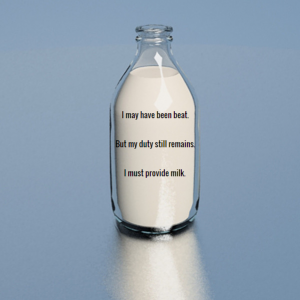I may have been beat.
But my duty still remains.
I must provide milk.
What I decide to do for project 2 part 2 is a haiku inserted in a picture of a milk bottle. Now what exactly is a haiku? A haiku is a poem that consists 5 syllables on the first line, 7 on the second, and 5 on the last. This all adds up to 17 syllables.
The pivotal scene I chose for Part 1 of this project was the scene where Sethe was beaten down and had her milk stolen. This scene brought about many events in the story. Without those events, the story would have played differently.
As we know, Sethe developed sort of an obsession to provide her children with her breast milk. When she developed her own milk, all she could think about was giving what she couldn’t have as a child. However at one point of the story, Sethe was attacked by schoolteacher’s nephews and had her milk sucked right out of her (I may have been beat). Although this left a stain in her mind, she still wanted to give. It was her duty (But my duty still remains) and obsession to nurse her children (I must provide milk) Throughout the story we see this obsession and we see that she wanted to be the best mother she could.
For the haiku, I had to think pretty hard on how I wanted to write it. You’re limited to what you can write and there’s a set format you have to follow. I wanted to portray Sethe’s image as a dedicated mother while bringing up the milk robbing incident. As a result, I came up with what you see. To add a bit more creativity, I decided to use a simple image of a milk bottle (It was hard to pick one) and simply edit the haiku text inside it. The milk bottle (which can be seen as a bottle of cow milk) represents in which I believe is the way she was treated. Like most slaves, Sethe was treated poorly and it seemed like she was treated more as a cow than a human. Like a cow who has no control of who takes her milk, Sethe had no control in this situation.




